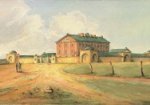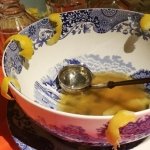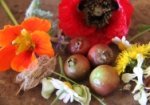Bring out the punchbowl and party like it’s 1799 with these recipes!
Punch was a typical drink served at colonial occasions, as its ingredients travelled easily – unlike imported wines, which could be very hit-and-miss affairs before the local industry was established. One of the key ingredients – rum – would become particularly notorious in New South Wales’s early history.
A short history of punch
Oh ignorant young creatures! What little do you know of the effect of rack punch! What is the rack in the punch at night, to the rack in the head at morning? To this truth I can vouch as a man, there is no headache in the world like that caused by a Vauxhall punch.
Vanity Fair, William Makepeace Thackery, (1847–8).
A raucous gathering around a punchbowl, and the inevitable consequences the next morning, was a recurrent theme among 18th and 19th-century satirists. The drunken free-for-alls depicted by William Hogarth and Thomas Rowlandson rank as iconic images of Georgian and Regency excess. The composition of Hogarth’s A modern midnight conversation (image below) was widely adapted by other artists and political cartoonists.
The name ‘punch’ doesn’t refer to the likely hangover after a binge but is actually derived from the Hindustani word panch, meaning ‘five’, a reference to the drink’s five original ingredients – citrus juice, sugar, water, rum and brandy. As an aside, panch phora – ‘five seeds’ – is a spice blend you may have tried in Indian cooking, made up of brown mustard, cumin, fennel, fenugreek and nigella seeds.
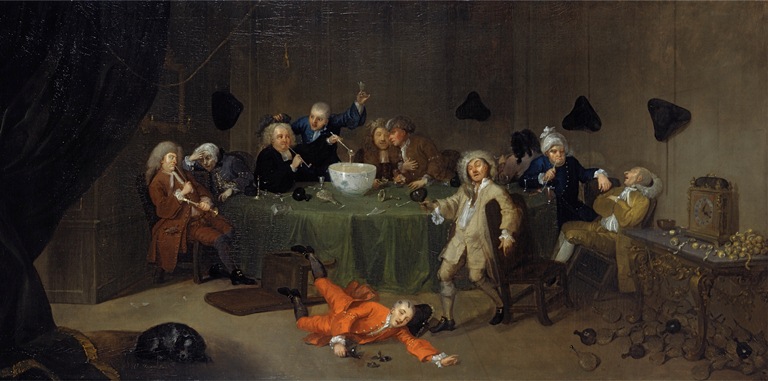
A midnight modern conversation, William Hogarth, c1732. Yale Center for British Art, Paul Mellon Collection
‘Rack punch’, the drink that undoes the characters in Vanity Fair (whether they drank it or not) was a heady mix of arrack – there is a wide variety of arracks, from south-east Asia right through to Morocco, made from local sugar cane, palm sugar etc – lemon juice, sugar and water. ‘Regent’s Punch’, named for George IV when he was acting as Regent for his incapacitated father, was a particularly popular – and extravagant – mix.
Thomas Cosnett’s The footman’s directory and butler’s remembrancer, being the advice of Onesimus to his young friends (another fabulous book title, published London, 1823) gives a conventional recipe (see p251):
One teaspoonful of Coxwell’s acid salt of lemons, a quarter of a pound of sugar, a quart of boiling water, half a pint of rum, and a quarter of a pint of brandy.
The ‘acid salt of lemons’ replaced the need to rasp fresh lemons on a sugar loaf first. Mrs Beeton also noted that:
… where fresh lemons or juice cannot be had for punch or similar beverages crystallised citric acid and a few drops of the essence of lemon will be very nearly the same thing.
If you look closely to the right of Hogarth’s painting (see detail below), you’ll notice a pile of squeezed citrus and discarded peel on the table – as well as a considerable pile of empty bottles on the floor. The curls of peel were used as decoration for the punchbowl, draped across the bowl and over the sides:
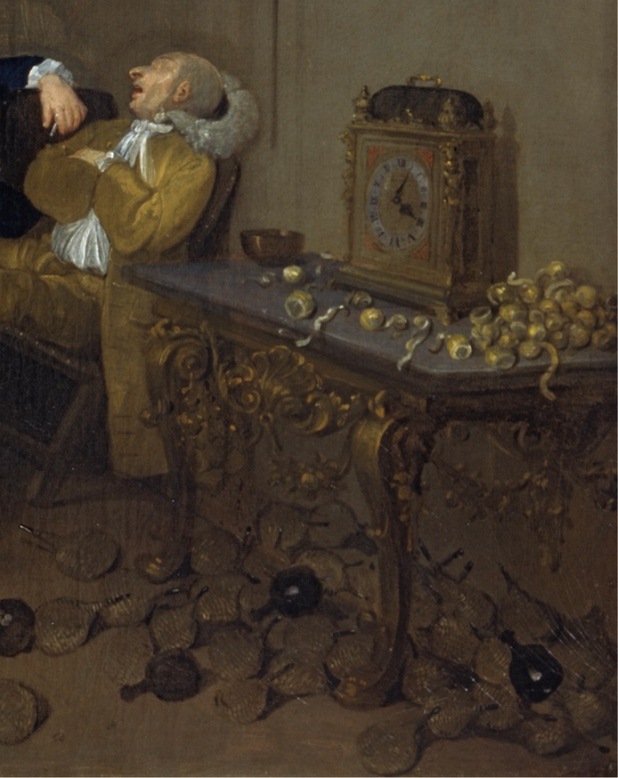
A pile of discarded bottles and citrus used in making punch, A midnight modern conversation (detail), William Hogarth, c1732. Yale Center for British Art, Paul Mellon Collection
Mrs Beeton’s ‘hot punch’
This recipe from Mrs Beeton is for a ‘hot punch’, and tweaks the basic form. It has quite a kick!
To make hot punch
½ pint of rum, ½ pint of brandy, ¼ lb of sugar, 1 large lemon, ½ tsp nutmeg, 1 pint boiling water.
Rub the sugar over the lemon until it has absorbed all the yellow part of the skin, then put the sugar into a punchbowl; add the lemon juice (free from pips) and mix these two ingredients well together. Pour over them the boiling water, stir well together, add the rum, brandy, and nutmeg; mix thoroughly, and the punch will be ready to serve. It is very important in making punch that all the ingredients are thoroughly incorporated; and to insure success, the process of mixing must be diligently attended to.
Mrs Beeton’s Book Of Household Management, 1861 edition. Item 1839, pp891–2
Beeton’s list of punches is lengthy; there were, after all, a myriad of individual variations.
The oldest recipe book in my own kitchen, Cassell’s household cookery (Melbourne, Cassell & Co, 1909), lists eight punches, but almost twice that number of ‘cups’ (another similar variety of mixed drink), plus a recipe for a ‘shrub’ that sounds like the ancestor of the Caipiroska (a popular South American mixed drink) .
It also includes an ‘American punch’ that ‘will be voted excellent on a warm day’, made of ‘a half ounce sugar, tablespoon of lemon juice, twice as much good port, the same of rum, and teaspoon or more of brandy’; pour over crushed ice and garnish with seasonal fruit. Interestingly, the American punch is the only recipe in which the ingredients are given per glass, rather than per bowl.
Punch and popularity
While punch is still drunk today, its popularity has waned from its peak in the Regency. The 1861 edition of Beeton’s Household management records that ‘Punch, which was almost universally drunk amongst the middle classes about fifty or sixty years ago, has almost disappeared from our domestic tables, being superseded by wine’. It is still included, however, in the book’s festive menus for weddings, suppers, balls and the like – and that’s exactly where you’ll typically find punch being drunk today.
The jolly, albeit melancholic, verse below is an excerpt from ‘A ballad of similes’, published in the Hobart Town Gazette, 8 March 1817. It was a Saturday, so I like to imagine the poem was read out in public bars – perhaps at The Sign of the Punch Bowl, an inn that was located on Clarence Street, Sydney – and drawing rooms alike that night, as everyone cheered and drank a toast:
That life is a journey no mortal disputes,
Then we’ll liquor our brains, boys, instead of our boots;
and each topper shall own, on life’s road as he reels,
That a spur in the head is worth two in the heels.If life’s like a lamp, then to make it shine brighter,
we’ll assign to Madeira, the post of lamp-lighter;
We’ll cherish the flame, with Oporto to Stout,
and drink Brandy-punch till we’re fairly burnt out.
Now if you’ll excuse me I’m off for a Bex and a lie down …
West Indian shrub and punch shrub
| Meal type | Beverage |
| Occasion | Banquet, Barbecue, Birthday Party, Casual Party, Christmas |
| From book | Cassell's Houehold Cookery, 1909 edn. |
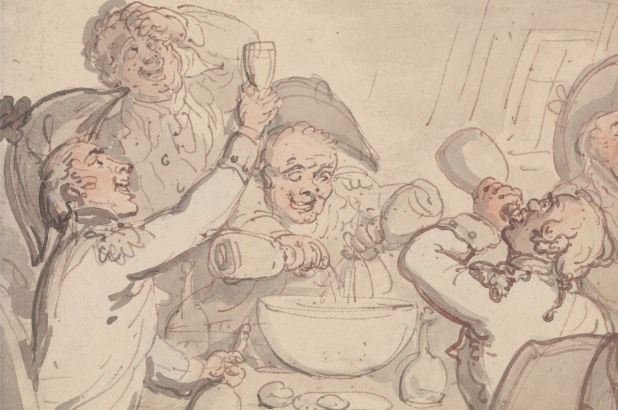
 Print recipe
Print recipe